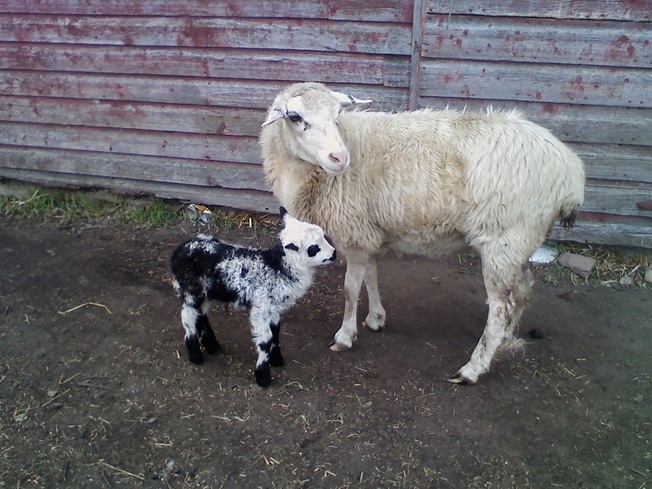 Lena, a Karakul sheep named after my mother and her daughter, Denise, a Shetland/Karakul lamb named after my daughter.
Lena, a Karakul sheep named after my mother and her daughter, Denise, a Shetland/Karakul lamb named after my daughter. I love to wear woollen socks and have several pairs, including commercially made mohair socks. The mohair socks are very soft and are absolutely the best for winter in rubber work boots. My feet seldom ever get cold because the boots are rated for minus 60C, but with the mohair socks, the moisture is wicked away and my feet stay warm enough. I even wear wool socks in the summer for the same reasons, not to stay warm, but to keep cool.
Sweaters of real wool were not something I much liked, but that was due to inferior wool that was scratchy. Then I purchased a cashmere sweater and that made me think that maybe, just maybe wool could be nice to wear next to my skin too. Organic Merino wool is soft and although not as light as cashmere, which actually comes from goats, it was warm and soft enough to be comfortable.
Now I have many sheep and after shearing, I learned what causes the wool to be scratchy. Young animals have a cuticle that is smooth, while older animals' cuticles are raised giving a sharper feel to the fiber. The worst culprit for scratchiness is vegetative matter, that is the hay, straw, burrs or other organic stuff lodged in the fibers. Washing, drying, carding, picking and combing prior to spinning removes most of the foreign matter, but when there is too much to begin with, not all will be released, giving the wool a terrible feel. Keeping the hay off the sheep is not an easy task and one that I struggle with to date, so my fleece is full of vegetative matter. Some shepherds who raise sheep strictly for wool, coat their sheep, which requires a change of coats up to six times a season so the wool does not matt. Others feed pellets or cubed hay to avoid the matter, but that is rather expensive. Keeping the sheep out of the area when loading feeders is a good thing, because they tend to stand under the spot where new hay is being loaded. Also, feeding sheep of the same size together is necessary so the taller ones do not pull hay down onto the backs of the smaller sheep. There are so many different types and qualities of wool, too, from coarse carpet type wool, perfect for felting or very fine crimped wool for hand spinning.
I pretty much have the idea of raising the sheep down an now need to concentrate on the breeds that are easy to manage, naturally pest resistant, thrive on a grass based operation and have beautiful wool. That is where the Babydoll Southdowns and Jacobs have won my vote. The next step is to build feeders that will assist in keeping the wool clean for next shearing and then learning to process the fleece into yarn so that I can make woollen things right here at the Fat Ewe Farm. Now that is hands on - hands on the sheep!

 RSS Feed
RSS Feed